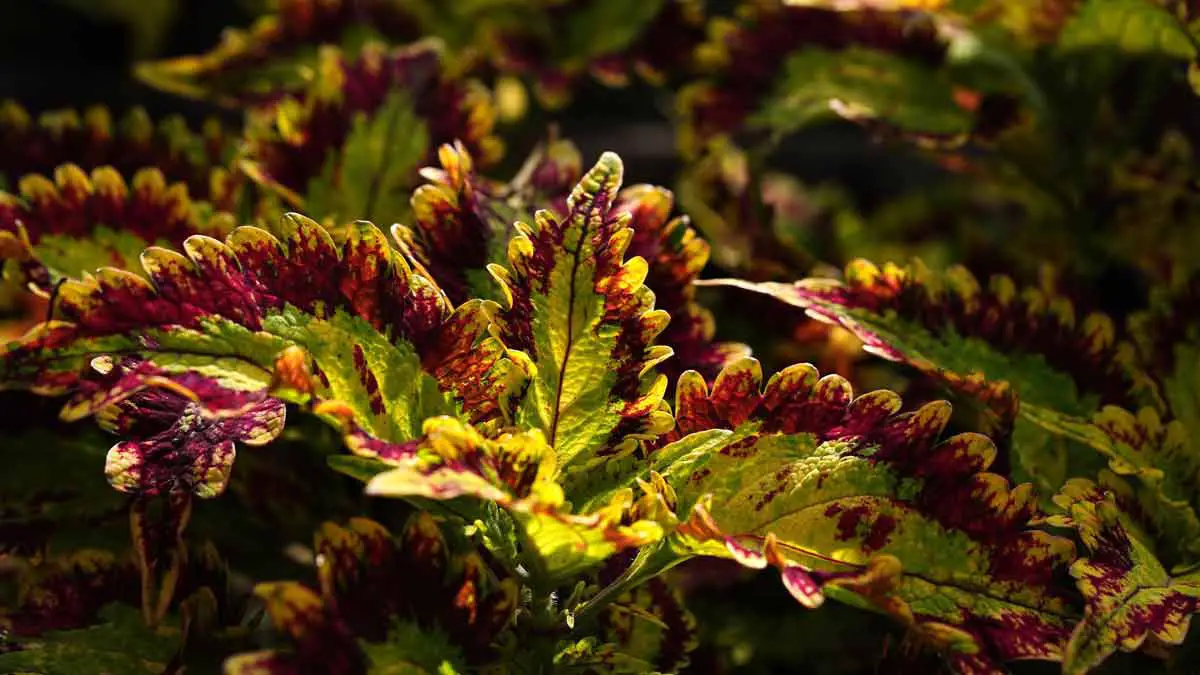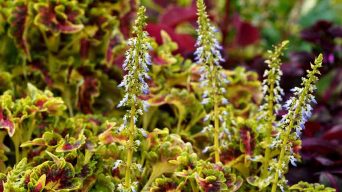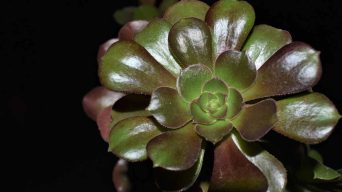An overwatered coleus is a common issue that occurs when the plant receives too much water, which can lead to root rot, yellowing, and drooping leaves. To fix it, try reducing the amount of water and checking the soil to ensure it is not waterlogged.
When caring for Coleus plants, it is important to be aware of the risks of overwatering. If not managed properly, this could lead to various issues affecting the plant’s health and vitality.
To help protect these vibrant and beautiful garden additions, it is essential for gardeners to understand how to identify, treat, and prevent an overwatered Coleus plant.
Root Rot
Overwatering can cause a major problem for plants: root rot.
Root rot occurs on coleus plants when there is too much water in the soil, causing the roots to become damaged and weak. This causes nutrient and water absorption to be reduced drastically, resulting in wilted leaves and eventual plant death if left untreated.
The best way to prevent root rot is to practice proper watering techniques and ensure that your soil is not oversaturated.
Fungal Diseases
Fungal diseases caused by fungi that thrive in wet conditions are a common consequence of overwatering coleus plants.
Botrytis blight and Downy mildew are two of the most prevalent and problematic fungal diseases that can affect coleus plants.
Botrytis blight is characterized by brown rotting leaves, while Downy mildew causes the coleus leaves to turn yellow and develop a white, fuzzy growth.
Preventive measures must be taken to protect coleus plants from these serious, difficult-to-treat fungal diseases.
Bacterial Problems
Plants can easily suffer from bacterial problems if they are overwatered. Bacteria tend to thrive in these conditions, leading to various illnesses that can cause serious damage or even death for the coleus plant.
Pseudomonas leaf spot and bacterial blight are two common bacterial diseases affecting coleus plants. Pseudomonas leaf spot can be identified by brown or black spots on the leaves.
On the other hand, bacterial blight is recognized by dark, water-soaked lesions on the leaves. If not treated quickly, these diseases can spread rapidly and cause irreversible damage to your plant.
Pest infestations
Proper watering is essential for your plant’s health and can help prevent pests from becoming a problem.
Too much water can increase susceptibility to pest infestations like aphids, whiteflies, and mealybugs.
These pests feed on the sap of plants, weakening them and leaving them vulnerable to fungal diseases such as powdery mildew and root rot.
To keep your plant healthy and pest-free, inspect it regularly and treat any issues promptly. This will help ensure your plant remains strong and stress-free.
How Does Overwatering a Coleus Occur?
Overwatering a coleus plant can happen in several ways, but the most common causes of this phenomenon are related to improper watering techniques.
The most common causes include the following:
Inadequate drainage
Inadequate drainage is one of the leading causes of overwatering.
When a pot lacks suitable drainage holes, water accumulates at the base and can begin to rot the plant’s roots.
Selecting a pot with sufficient drainage capability is important to avoid this issue. If uncertain, you can always drill extra holes at the bottom of the pot.
Incorrect watering schedule
Watering your plants correctly is essential to keeping them healthy, so it is important to avoid overwatering.
Overwatering can be caused by an incorrect watering schedule, where people water their plants daily, even when the soil is moist. This can lead to root damage and cause the plant to die.
To ensure you are watering your plants correctly, check the soil before doing anything else. If dry, you should water the plant in the morning so the leaves have time to dry before nightfall.
This will help prevent fungal diseases commonly caused by too much moisture.
Improper Watering Technique
When caring for a plant, it is important to ensure that the watering schedule is correct to avoid overwatering.
The best way to water plants is to target their base directly, not wetting their leaves. This will help prevent the spread of fungal diseases through the foliage.
When watering your plants, make sure that you do so thoroughly; let any excess water drain away so that the plant isn’t left sitting in moisture. This can lead to root rot and other issues caused by overwatering.
Using the Wrong Soil
When watering your plants, making the right soil choice is key.
Using a potting mix that does not provide adequate drainage can lead to overwatering, which will eventually cause the roots to rot.
To prevent this from happening and ensure proper drainage, consider choosing a potting mix that is specifically designed for draining water away quickly and efficiently.
Adding sand or perlite to the mix can also improve drainage and promote healthy root growth.
Using a Pot That’s Too Small
Overwatering can often be avoided by ensuring that the pot chosen for a plant is large enough to provide adequate room for the roots to spread and absorb all of the water it needs.
The best way to do this is to select pots twice as wide as the plant’s rootball, allowing sufficient space for the roots to take in all their required moisture.
Doing this will reduce the risk of wilting and potential death, as overwatering can be especially damaging when there is inadequate space for the roots to expand.
Watering With Hard Water
Watering with hard water can cause serious issues for plants, such as overwatering.
Hard water contains a high concentration of minerals like calcium and magnesium, which can accumulate in the soil and create a barrier between the plant roots and the water. This prevents adequate absorption, leading to wilting and death if not treated.
To avoid this, use distilled or filtered water and let it sit for 24 hours to allow the minerals to settle.
How To Identify If Your Coleus Is Overwatered?
Watering Coleus plants too often can have serious consequences. Thus, it is important to recognize the telltale signs of overwatering to protect your plant’s health.
Signs of an Overwatered Coleus Plant
When caring for your houseplant, knowing the signs of overwatering is important. Too much water can cause root rot and other problems that may damage or kill your plant.
Pay attention to the following telltale signs that your plant may be getting too much water:
1. Wilting Leaves
When it comes to overwatering, one of the most telling signs is wilting leaves. Coleus plants will start to show wilting when they are not receiving enough water.
However, it can also be an indication of too much water being provided.
To tell the difference between the two, you should check the soil; if it is moist, there is likely too much water, and if it is dry, more water is needed.
2. Yellow or Brown Leaves
Overwatering a plant can lead to yellow or brown leaves, indicating that the roots are not getting enough oxygen and thus are suffocated.
This problem can be seen in many house plants, but it’s important to identify it quickly and take action before the plant begins to suffer any permanent damage.
To prevent this from happening, it is important to let the plant dry out and ensure adequate drainage.
3. Drooping Leaves
When you overwater your coleus, one of the most telling signs is that its leaves begin to droop.
This is because the roots take in too much water and not enough oxygen, thus depriving the leaves of what they need to stay upright.
To prevent this from happening, it is important to water your plant less frequently if you notice coleus leaves drooping.
4. Soggy or Mushy Soil
The overwatering of coleus can result in soggy or even mushy soil, as the roots cannot absorb all the excess water that pools in the pot.
It is essential to recognize that inadequate soil drainage can have similar consequences. To assess whether it is too wet or if there is a lack of drainage, examine the bottom of the pot.
Pooled water in the bottom of the pot indicates poor drainage.
5. Soft or Mushy Stems
Overwatering your plants can cause their stems to become soft and mushy due to the inability for the waterlogged roots to provide adequate support.
This lack of structural strength can cause the plant’s stem to collapse and is easily identified by the soft, spongy texture of the stems.
To prevent this from occurring, reducing the frequency of watering your plants is necessary.
6. Fungus or Mold
Overwatering your plants is a major cause of fungus and mold growth due to the ideal wet conditions it creates.
If you notice signs of either on the plant or the soil, it’s time to cut back on watering and relieve your plant.
Fungus and mold thrive in humid and moist environments, making them more likely to appear on an overwatered plant.
7. Slow Growth
Overwatering your plant can significantly inhibit its growth. When this is the case, it is likely because the roots of the plant do not have enough space to absorb all the water that has been applied, leading to a lack of vital nutrients.
In turn, this causes slower growth and development in the plant.
If you notice a decrease in the growth rate in your plant, it is likely due to overwatering, and you should reduce the frequency with which you water your plant.
How To Save an Overwatered Coleus Plant
Gardeners often find themselves in the unfortunate situation of having an overwatered Coleus plant. If spotted early enough, however, it is possible to save your prized greenery from a potentially fatal mistake.
Gardeners should take the following course of action to bring a wilting Coleus back from the brink of death.
1. Stop Watering Your Coleus Plant
Instead of pouring water onto an overwatered plant, the best action is to stop giving it more water. This will give its roots a chance to recover from the excessive moisture and start functioning properly again.
To ensure your plant does not suffer further damage, you should wait until the soil has completely dried out before you resume your watering routine.
2. Prune Your Coleus Plant
Prune your plant once the soil has dried to help stimulate new growth and remove any damaged leaves that have become yellow or brown due to overwatering.
Pruning is an essential part of properly caring for plants as it helps them flourish by removing dead or dying foliage, improving air circulation, and promoting the development of healthy new shoots.
Pruning also helps improve the overall aesthetic of your plant, as it encourages full and lush growth.
3. Repot Your Coleus Plant
Repotting your Coleus plant is an essential step to take if it has been overwatered.
When soil is waterlogged, its consistency becomes compacted, making it difficult for the plant to get the nutrients it needs. This can cause damage to the roots of the plant, impairing its ability to absorb these important substances.
Remove it from its current pot and replant it in new soil to give your plant a fresh start and aid in its recovery.
4. Remove Affected Roots
Gently loosen the soil around the base of your plant to remove any damaged or dead roots. Use a sharp knife to cut away any black or brown roots carefully.
Take care to ensure that all affected roots are removed from the soil. Afterward, fill the area with fresh potting soil and deep water your plant to help it recover.
5. Cut Back on Fertilizer
Watering your coleus plant too much can harm its health, so it is important not to overwater it.
Before fertilizing this plant, you should wait until it has fully recovered and is well-established.
Fertilizing an overwatered plant can cause the roots to become damaged and prevent it from recovering.
6. Place Your Coleus Plant in a Bright, Sunny Spot
Coleus plants thrive when they are exposed to bright, indirect sunlight.
To ensure they receive the proper amount of sunlight, placing them in a spot that gets at least four hours of direct sunlight daily is important.
If your Coleus plant is overwatered, this could indicate that it is not receiving enough light, as too much shade can cause the plant to struggle. To help your Coleus recover, move it to a bright, sunny spot.
7. Water Your Coleus Plant Carefully
When caring for your houseplant, paying attention to how much water it needs is important.
To ensure that your plant doesn’t become overwatered, only water when the top layer of soil has dried. Check this by lightly pressing your finger into the potting mix – if it feels dry and crumbly, it’s time to water.
Allow the soil to drain well after each watering, as this will help prevent root rot and other issues caused by too much moisture in the potting mix.
8. Monitor Your Plant Closely
To prevent overwatering, keep a close eye on your plants and watch for any signs that may indicate potential harm.
If you spot any such signs, immediately cease watering your plant and allow the soil to dry out completely. Pruning is also beneficial in promoting healthy new growth while removing damaged leaves.
9. Be Patient
Carefully tending to a coleus plant that has been overwatered is essential for it to revive and return to its full, thriving potential.
To give the plant a fighting chance, the gardener must be patient and provide plenty of time to recover.
With proper care and attention, it is possible that an overwatered coleus plant can come back to life.
How To Prevent Overwatering a Coleus Plant
To prevent overwatering a coleus plant, water only when the soil is dry to the touch and check the soil before watering.
Never let the plant sit in water, and if using a container with no drainage holes, empty any excess water from the saucer after watering.
Provide adequate drainage by using a well-draining potting mix and pots with drainage holes.
Monitor your plant closely for signs of overwatering, especially if you live in a humid climate where too much humidity can be an issue.
Take action immediately if you see any yellow or brown leaves. With proper care, you can keep your coleus plant healthy and thriving.
Final Thoughts
When you overwater your Coleus, the results are not very pleasing to behold.
The leaves become sodden and lose their vibrant color, and if left untreated, the plant will eventually perish.
While overwatering is common with Coleus plants, it is easy to prevent by taking the right steps.
So if you suspect that your beloved Coleus might be getting too much water, don’t hesitate to act quickly and take corrective measures.







